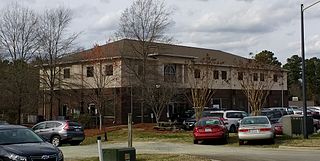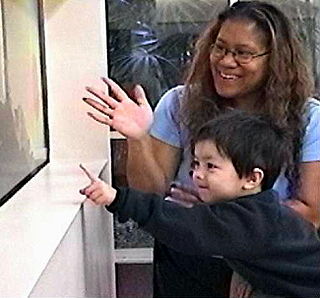Related Research Articles

Autism is a neurodevelopmental disorder characterized by difficulties with social interaction and communication, and by restricted and repetitive behavior. Parents often notice signs during the first three years of their child's life. These signs often develop gradually, though some autistic children experience regression in their communication and social skills after reaching developmental milestones at a normal pace.

Asperger syndrome (AS), also known as Asperger's, is a neurodevelopmental disorder characterized by significant difficulties in social interaction and nonverbal communication, along with restricted and repetitive patterns of behavior and interests. It is an autism spectrum disorder (ASD), but differs from other ASDs by relatively unimpaired language and intelligence. Although not required for diagnosis, physical clumsiness and unusual use of language are common. Signs usually begin before two years of age and in many cases never resolve.
Lip reading, also known as speechreading, is a technique of understanding speech by visually interpreting the movements of the lips, face and tongue when normal sound is not available. It relies also on information provided by the context, knowledge of the language, and any residual hearing. Although lip reading is used most extensively by deaf and hard-of-hearing people, most people with normal hearing process some speech information from sight of the moving mouth.
Developmental disorders comprise a group of psychiatric conditions originating in childhood that involve serious impairment in different areas. There are several ways of using this term. The most narrow concept is used in the category "Specific Disorders of Psychological Development" in the ICD-10. These disorders comprise developmental language disorder, learning disorders, motor disorders, and autism spectrum disorders. In broader definitions ADHD is included, and the term used is neurodevelopmental disorders. Yet others include antisocial behavior and schizophrenia that begins in childhood and continues through life. However, these two latter conditions are not as stable as the other developmental disorders, and there is not the same evidence of a shared genetic liability.
Discrete trial training (DTT) is a technique used by practitioners of applied behavior analysis (ABA) that was developed by Ivar Lovaas at the University of California, Los Angeles (UCLA). DTT uses direct instruction and reinforcers to create clear contingencies that shape new skills. Often employed as an early intensive behavioral intervention (EIBI) for up to 30–40 hours per week for children with autism, the technique relies on the use of prompts, modeling, and positive reinforcement strategies to facilitate the child's learning. It previously used aversives to punish unwanted behaviors. DTT has also been referred to as the "Lovaas/UCLA model", "rapid motor imitation antecedent", "listener responding", errorless learning", and "mass trials".

Applied behavior analysis (ABA), also called behavioral engineering, is a scientific technique concerned with applying empirical approaches based upon the principles of respondent and operant conditioning to change behavior of social significance. It is the applied form of behavior analysis; the other two forms are radical behaviorism and the experimental analysis of behavior.

Augmentative and alternative communication (AAC) encompasses the communication methods used to supplement or replace speech or writing for those with impairments in the production or comprehension of spoken or written language. AAC is used by those with a wide range of speech and language impairments, including congenital impairments such as cerebral palsy, intellectual impairment and autism, and acquired conditions such as amyotrophic lateral sclerosis and Parkinson's disease. AAC can be a permanent addition to a person's communication or a temporary aid. Stephen Hawking used AAC to communicate through a speech-generating device.

The University of North Carolina TEACCH Autism Program creates and disseminates community-based services, training programs, and research for individuals of all ages and skill levels with autism spectrum disorder (ASD), to enhance the quality of life for them and their families across the lifespan.
The Autism Diagnostic Observation Schedule (ADOS) is an instrument for diagnosing and assessing autism. The protocol consists of a series of structured and semi-structured tasks that involve social interaction between the examiner and the person under assessment. The examiner observes and identifies segments of the subject's behavior and assigns these to predetermined observational categories. Categorized observations are subsequently combined to produce quantitative scores for analysis. Research-determined cut-offs identify the potential diagnosis of classic autistic disorder or related autism spectrum disorders, allowing a standardized assessment of autistic symptoms. The Autism Diagnostic Interview-Revised (ADI-R), a companion instrument, is a structured interview conducted with the parents of the referred individual and covers the subject's full developmental history.

Autism therapies are interventions that attempt to lessen the deficits and problem behaviours associated with autism spectrum disorder (ASD) in order to increase the quality of life and functional independence of individuals with autism. Treatment is typically catered to the person's needs. Treatments fall into two major categories: educational interventions and medical management. Training and support are also given to families of those with ASD.
Pivotal response treatment (PRT), also referred to as pivotal response training, is a naturalistic form of applied behavior analysis used as an early intervention for children with autism that was pioneered by Robert and Lynn Koegel. PRT advocates contend that behavior hinges on "pivotal" behavioral skills—motivation and the ability to respond to multiple cues—and that development of these skills will result in collateral behavioral improvements. In 2005, Richard Simpson of the University of Kansas identified pivotal response treatment as one of the four scientifically based treatments for autism.
Social Stories were devised as a tool to help individuals with ASD better understand the nuances of interpersonal communication so that they could "interact in an effective and appropriate manner". Although the prescribed format was meant for high functioning people with basic communication skills, the format was adapted substantially to suit individuals with poor communication skills and low level functioning. The evidence shows that there has been minimal improvement in social interaction skills. However, it is difficult to assess whether the concept would have been successful if it had been carried out as designed.
The developmental social-pragmatic model (DSP) is a developmental intervention that focuses on initiation and spontaneity in communication and following the child's focus of attention and motivations. Developmental interventions focus on a child's ability to form positive, meaningful relationships with other people when these are hampered by autism spectrum disorders such as autism or Asperger syndrome, or developmental disorders. It aims to build on the child's current communicative repertoire, even if this is unconventional; and using more natural activities and events as contexts to support the development of the child's communicative abilities.

Joint attention or shared attention is the shared focus of two individuals on an object. It is achieved when one individual alerts another to an object by means of eye-gazing, pointing or other verbal or non-verbal indications. An individual gazes at another individual, points to an object and then returns their gaze to the individual. Scaife and Bruner were the first researchers to present a cross-sectional description of children's ability to follow eye gaze in 1975. They found that most eight- to ten-month-old children followed a line of regard, and that all 11- to 14-month-old children did so. This early research showed it was possible for an adult to bring certain objects in the environment to an infant's attention using eye gaze.
Video modeling (VM) is a mode of teaching that uses video recording and display equipment to provide a visual model of the targeted behaviors or skill. In video self-modeling (VSM), individuals observe themselves performing a behavior successfully on video, and then imitate the targeted behavior. Video modeling has been used to teach many skills, including social skills, communication, and athletic performance; it has shown promise as an intervention for children with autism spectrum disorders (ASD). Important practical and theoretical questions remain largely unanswered about video modeling and other forms of video-based intervention.
Several factors complicate the diagnosis of Asperger syndrome (AS), an autism spectrum disorder (ASD). Like other ASD forms, Asperger syndrome is characterized by impairment in social interaction accompanied by restricted and repetitive interests and behavior; it differs from the other ASDs by having no general delay in language or cognitive development. Problems in diagnosis include disagreement among diagnostic criteria, the controversy over the distinction between AS and other ASD forms or even whether AS exists as a separate syndrome, and over- and under-diagnosis for non-technical reasons. As with other ASD forms, early diagnosis is important, and differential diagnosis must consider several other conditions.

The autism spectrum or autistic spectrum encompasses a range of neurodevelopmental conditions, including autism and Asperger syndrome, generally known as autism spectrum disorders or autistic spectrum disorders (ASD). Individuals on the autistic spectrum typically experience difficulties with social communication and interaction and may also exhibit restricted, repetitive patterns of behavior, interests, or activities. Symptoms are typically recognized between one and two years of age in boys. However, many children are not diagnosed until they are older. It is also common for diagnosis to be received as an adolescent or as an adult. The term "spectrum" refers to the variation in the type and severity of symptoms. Those in the mild range are typically able to function independently, with some difficulties in their daily lives, while those with moderate to severe symptoms may require more substantial support in their daily lives. Long-term problems may include difficulties in daily living such as managing schedules, hypersensitivities, creating and keeping relationships, and maintaining jobs.

Autism is a variation of neural development diagnosed as impaired social interaction and communication, and by restricted and repetitive behavior. In this article, the word autism is used for referring to the whole range of variations on the autism spectrum, which is not uncommon.
The Verbal Behavior Milestones Assessment and Placement Program (VB-MAPP) is an assessment and skills-tracking system to assess the language, learning and social skills of children with autism or other developmental disabilities. A strong focus of the VB-MAPP is language and social interaction, which are the predominant areas of weakness in children with autism.
The Picture Exchange Communication System (PECS) is an augmentative and alternative communication system developed and produced by Pyramid Educational Consultants, Inc. PECS was developed in 1985 at the Delaware Autism Program by Andy Bondy, PhD, and Lori Frost, MS, CCC-SLP. The developers of PECS noticed that traditional communication techniques, including speech imitation, sign language, and picture point systems, relied on the teacher to initiate social interactions and none focused on teaching students to initiate interactions. Based on these observations, Bondy and Frost created a functional means of communication for individuals with a variety of communication challenges. Although PECS was originally developed for young children with autism spectrum disorder (ASD), its use has become much more widespread. Through the years, PECS has been successfully implemented with individuals with varying diagnoses across the aged span. PECS is an evidence-based practice that has been highly successful with regard to the development of functional communication skills.
References
- ↑ Bopp, K.D., et al. 2004. "Speech-language pathologists' roles in the delivery of positive behavior support for individuals with developmental disabilities." Am.J Speech Lang Pathol. 13(1):5-19.
- ↑ Wheeler, J.J., and S.L. Carter. 1998. "Using Visual Cues in the Classroom for Learners with Autism as a Method for Promoting Positive Behavior." B.C.Journal of Special Education v21 n3 p64-73 1998.
- 1 2 Kimball, J.W., et al. 2003. "Lights, Camera, Action! Using Engaging Computer-Cued Activity Schedules." TEACHING Exceptional Children v36 n1 p40-45 Sep-Oct 2003.
- ↑ Bryan, L.C., and D.L. Gast. 2000. "Teaching on-task and on-schedule behaviors to high-functioning children with autism via picture activity schedules." J Autism Dev.Disord. 30(6):553-567.
- ↑ Morrison, R.S., et al. 2002. "Increasing Play Skills of Children with Autism Using Activity Schedules and Correspondence Training." Journal of Early Intervention v25 n1 p58-72 Win-Spr 2002.
- ↑ Green, V.A., K.A. Pituch, J. Itchon, A. Choi, M. O'Reilly, J. Sigafoos, "Internet survey of treatments used by parents of children with autism," Res Dev Disabil, 2006, 27(1):70-84.